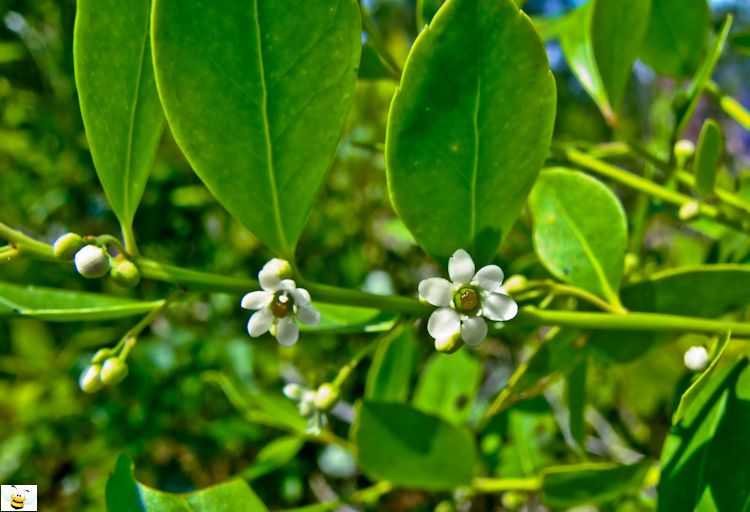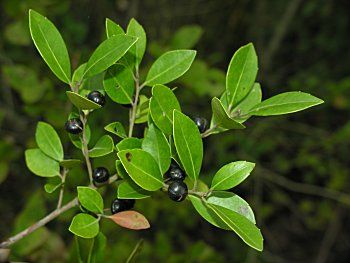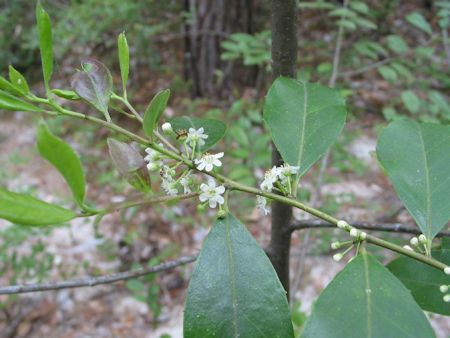Gallberry Honey is
A Flatwoods Treasure…
Although not well known in general... Gallberry Honey has established a name within certain groups.
- If you live in an area where it is available you will prize it as a honey to keep on your table... sweetening things on the fly or you may discover you enjoy a chunk of honey comb instead.
- If you operate a bakery you may find it on your shelf of special ingredients for a sweet and somewhat bold flavor that enhances your baked goods.
- If you are in the business of packing honey you will find that including Gallberry Honey in your mix will improve shelf life of your commercial product.
And... that will about exhaust the available supply of this sweet treasure that is gathered in the flatwoods of eastern and southern coastal regions of North America. While the plant can be a prolific nectar source the native regions are relatively small and this is a honey variety that is not commonly available everywhere.

WHIZZ NOTE: This plant nearly goes undetected as a valuable honey plant with its small hidden flowers. Nothing gets past us though and you will like to have this one in your kitchen!
Flavor... is typically bolder with a mild sorghum or molasses flavor.
Color... is lighter when pure! However it is nearly impossible to collect pure Gallberry honey due to the nature of its habitat and other attractive plants blooming at the same time. Usually you will find it available dark amber in color.
Storage... is very good among honeys. This honey has a higher than typical level of levulose... a fructose sugar. This gives it very stable shelf life preventing it from crystallizing quickly, even in cold temperatures.

Plant:
The gallberry plant is also known as inkberry in local circles. This broadleaf evergreen shrub is a member of the Holly family and thrives in the wet, sandy, and acidic soils of the flatwoods country.
It spreads out three to four feet wide and stretches up to six or eight feet tall in some cases. Dense foliage will choke out smaller plants around it but it can begin to struggle for sunlight by taller trees so regular area burnings can stimulate this plant.
Leaves are narrow and oval about one to two inches long with a leathery like feel and no spines.
Bloom:
Small white to greenish-white blossoms emerge in late April to early June typically just after citrus groves have flowered. Flowers are not showy as blooms are small and low to the stems making them difficult to see at any distance. Dark blue berries are also small and hang on for most of the winter.
Location:
This honey is somewhat isolated in its production areas. The Gallberry plant is native to North America along the eastern coasts to the southern Atlantic and Gulf Coasts. This is a popular honey in the Carolina's Florida, and Georgia with Georgia producing most of its honey crop from this nectar source.
In addition, Gallberry has been propagated in areas of Europe and has increased in popularity there in recent years. It has high potential for those looking for a honey that crystallizes slowly.
Honey and Pollen Potential:
The Gallberry plant nearly drips nectar and is an important nectar source for beekeepers in its native locations... many times producing 80-100 lbs per hive.
It is a very reliable nectar source and you can expect a reasonable crop year after year. You will find the best honey production in years when there is plenty of regular water available and lots of sunshine.
Even with all these positive qualities... there can be challenges to collecting this as a monofloral honey. Usually beekeepers will move honey bees to the flatwoods country after citrus groves have flowered for orange blossom honey. The Gallberry plant is wild and does not grow isolated but among many other pine forest plants... some of these other plants will possibly be in bloom at the same time as Gallberry, like Palmetto.
It can become quite difficult to monitor and collect honey that is truly monofloral Gallberry but you will nearly always capture the character of this unique nectar source in your honey!

This sweet natural honey treasure of the south Atlantic regions will not disappoint you.
Its unique bold flavor complements many dishes and baked goods. Try a Gallberry Honey glaze on your next grilled salmon. Gallberry comb honey is also a popular treat!
Honey › Good Honey Plants › Gallberry Honey




